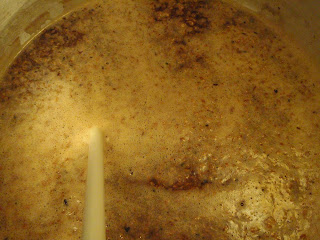




Did not post about this immediately after I did it, probably due in large part to the massive kitchen renovation that started the day after the night I did this. By "this", I of course mean my attempt to become a true purist in the world of homebrew: an all-grain batch.
What this really refers to is actually purchasing malted barley and other grains, get them milled, then extract the precious sugars and other nutriets from the endosperms of those grains through a process called mashing.
Finally, after the boil that occurs with all brewing, yeast is added, which metabolizes the solution called wort (rhymes with 'kurt'). This is a little more involved than extract brewing, but supposedly the results are much better. I chose to make a Belgian Dubbel, which should be a high gravity brown-ish ale with lots of maltiness, some esters, as ABV of around 7-8%.
You are able to see some pics of my set up and the mash to the left, though for some reason, I cannot get Picasa to permanently rotate a photo...including the one to the left of my modified 8-gallon aluminum kettle/mash tun (mashing vessel). Using a step-drill, I added a spout and screen (not pictured, but on the inside), and a thermometer to give continual readings of the mash temp (this and pH are two critical elements to mashing properly).
Here's a post of mine to Homebrewchatter.com, a forum that has many experienced homebrewers checking it throughout the day...I got many good responses, but was still not able to figure out why I was unable to get better efficiency (ie extract more sugar from the grains for my wort).
So I finally took the leap to AG last night. I had purchased an aluminum 8 gallon pot from a restaurant supply store (which it turns out, at which I was not allowed to shop, but the cashier decided to hook me up...only $30!).
Yesterday I went down to my homebrew retailer, planning on buying a simple screen/valve assembly for a cooler. No go. He didn't have any of THOSE left, however he did have an assembly to use an 8-gallon pot as a lauter tun. So I stopped by the hardware store, purchased a step drill, modified the pot for a valve, screen filter, and thermometer (also a purchase @ the HB store), but not before I had walked out of the homebrew store with the ingredients for a Belgian Dubbel and an extra fermentor:
1 lb Briess American Dextrin (carapils malt)
7.5 lbs Muntons English Maris Otter Malt
0.1 lbs Weyermann German Dehusked CaraFa II
0.5 lbs Dingemans Belgian Aromatic Malt
1 lb Dingemans Beglian Special B
1 lb candi sugar
1 lb honey (he had this AWESOME stuff called "Meadowfoam", which is truly delicious, to the point where I may make some meade from it)
1oz Brewers Gold pellets (60 min)
1/2 oz Hallertau (20 min)
1/4 oz Hallertau (10 min)
Wyeast #1214 Belgian Abbey Yeast
A couple of things happened:
1.) Always make sure there is enough room for a valve assembly to close if you are installing a thermometer in the same pot. After a tapestry of obscenities thinking I ruined a pot, I added an extra gasket so the thermometer is able to fit. (A friend of mine stopped by later and suggested to simply rotate the valve assembly...thank God for friends)
2.) As I was attempting to wake up the yeast by smacking the activator pack, a good bit of it splattered out on me (stain about the size of a softball on my shirt). I sanitized the outside of the package with some spray Star San and let it sit while I mashed/boiled.
3.) I realized that unless this beer REALLY sucks, I will likely not brew an extract again.
A couple questions:
1.) I came out with a 1.030 boil gravity. I measured immediately after lautering, but I feel like this is low. I used 13.5 quarts of water for the mash, and yielded just about 5 gallons of wort, and with 9 total pounds of grain, that only comes out to 16ppg. Isn't that a pretty miserable yield?
2.) Should I repitch more yeast? I want to not only make sure I get a good fermentation, but also that there is enough so I get a good carbonation.
3.) I had a full gallon of boil-off during the boil, so I added a little over a gallon of water. Since my charcoal filter was totally effed, I ended up using about a half gallon of filtered water and and a half gallon of UNFILTERED tap water. Problem?
Thanks in advance for the help!
Mike
In any event, the brew is still in the can and bubbling...it looks like that and the california common will be ready around the same time!
PS, cracked a bottle of the IPA on Saturday night and while a little undercarbed, it was amazing. Nice hop aromas, but very well balanced with a nice maltiness and a hop finish. Can't wait to drink more of these...